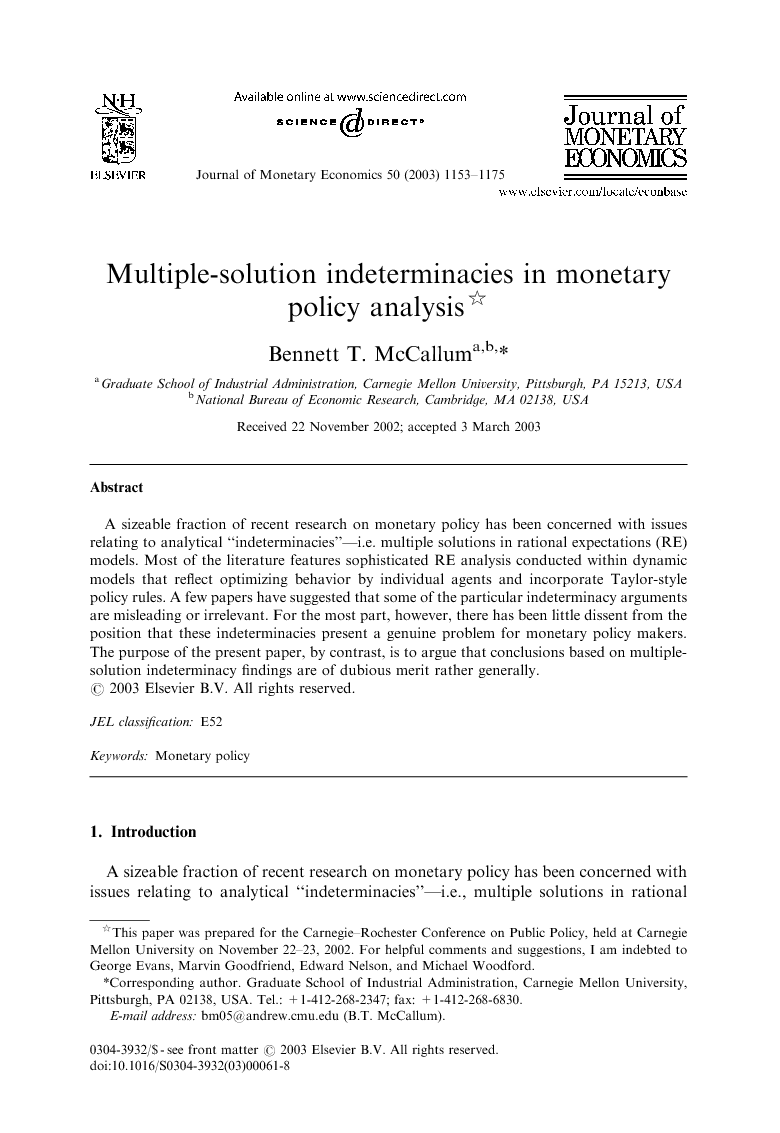عدم قطعیت چند راه حل در تجزیه و تحلیل سیاست های پولی
| کد مقاله | سال انتشار | تعداد صفحات مقاله انگلیسی |
|---|---|---|
| 24972 | 2003 | 23 صفحه PDF |

Publisher : Elsevier - Science Direct (الزویر - ساینس دایرکت)
Journal : Journal of Monetary Economics, Volume 50, Issue 5, July 2003, Pages 1153–1175
چکیده انگلیسی
A sizeable fraction of recent research on monetary policy has been concerned with issues relating to analytical “indeterminacies”—i.e. multiple solutions in rational expectations (RE) models. Most of the literature features sophisticated RE analysis conducted within dynamic models that reflect optimizing behavior by individual agents and incorporate Taylor-style policy rules. A few papers have suggested that some of the particular indeterminacy arguments are misleading or irrelevant. For the most part, however, there has been little dissent from the position that these indeterminacies present a genuine problem for monetary policy makers. The purpose of the present paper, by contrast, is to argue that conclusions based on multiple-solution indeterminacy findings are of dubious merit rather generally.
مقدمه انگلیسی
A sizeable fraction of recent research on monetary policy has been concerned with issues relating to analytical “indeterminacies”—i.e., multiple solutions in rational expectations (RE) models. Prominent topics for which this type of indeterminacy is central to the analysis include (i) the “Taylor principle” (Clarida et al (1999) and Clarida et al (2000); King, 2000; Woodford, 2002); (ii) inflation forecast targeting (Woodford (1994a) and Woodford (2002); Bernanke and Woodford, 1997; Kerr and King, 1996; Carlstrom and Fuerst, 2001; Bullard and Mitra, 2002); (iii) the zero-lower-bound deflation trap (Benhabib et al (2001) and Benhabib et al (2002); Alstadheim and Henderson, 2002); (iv) the fiscal theory of the price level (Woodford (1994b), Woodford (1995) and Woodford (2001); Sims, 1994; Cochrane, 1998; Kocherlakota and Phelan, 1999). The papers just mentioned, moreover, include only a sample of leading items, not an exhaustive listing. Most of the literature features sophisticated RE analysis conducted within dynamic models that reflect optimizing behavior by individual agents and incorporate Taylor-style policy rules. A few papers have suggested that some of the particular indeterminacy arguments are misleading or irrelevant; these include Buiter (1999) and McCallum (1999b), McCallum (2001a) and McCallum (2001b)). For the most part, however, there has been little dissent from the position that these indeterminacies present a genuine problem for monetary policy makers. The purpose of the present paper, by contrast, is to argue that conclusions based on multiple-solution indeterminacy findings are of dubious merit rather generally. In each of the mentioned cases, that is, there is at most one RE solution that should be regarded as plausible, the others reflecting theoretical curiosities that are not of relevance for actual economies. As it happens, the plausible solution in most or all of the cases studied is the minimum-state-variable (MSV) solution defined in McCallum (1983) and McCallum (1999b), which is unique by construction in linear models. The principle basis of the argument developed here depends, however, not on any alleged “fundamental” or “bubble-free” nature of the MSV solution, but on the E-stability and adaptive learnability of this solution as defined and explored in important recent publications by Evans and Honkapohja (1999) and Evans and Honkapohja (2001)). The outline of the paper is as follows. In Section 2, two preliminary issues of a partly terminological but also substantive nature are taken up, so as to avoid ambiguity or confusion later in the discussion. Next, Section 3 provides a brief summary of the E-stability/least-squares learnability approach and includes a brief argument for its importance. Then in 4, 5, 6 and 7 the four topics mentioned above are considered in turn, with each presented in the simplest possible setting. Finally, a short concluding section is provided.
نتیجه گیری انگلیسی
8. Concluding remarks The foregoing pages have discussed four current topics in monetary policy analysis, each of which hinges in some way on the possibility of multiple solutions that satisfy the usual definition of rational expectations. In two of these cases,30 analysis of the adaptive learnability of the multiple solutions suggests that only one of them is a viable candidate for a RE equilibrium when account is taken of the need for corrections to occur in response to small departures away from that equilibrium. Thus it is suggested that the dangers alleged to prevail, in these cases, are not ones with which actual policymakers need to be concerned. In the case of the Taylor principle, by contrast, it has been argued that the consequences of policy behavior that violates the principle are genuinely undesirable, since all of the RE equilibria fail to be learnable. Finally, our analysis of the simplest version of the fiscal theory of the price level suggests that the traditional solution is learnable and the fiscalist solution is not. With more general specifications of the policy rules, the outcome is not so clear-cut. It appears doubtful, nevertheless, that any equilibrium, in which price level and money stock behavior are very different, is learnable. More generally, these examples suggest that learnability, not indeterminacy, should be viewed as the relevant issue for policy-oriented theoretical analysis of monetary policy. More contentiously, it might be argued that RE solution multiplicity should be viewed basically as a mathematical curiosity, stemming from an insufficiently specific definition of rational expectations, rather than as a substantive problem for actual policy makers. Whatever the conclusion drawn, a unified treatment would of course provide a more attractive argument than the foregoing catalog of examples. I hope to be able to produce one in the future.

